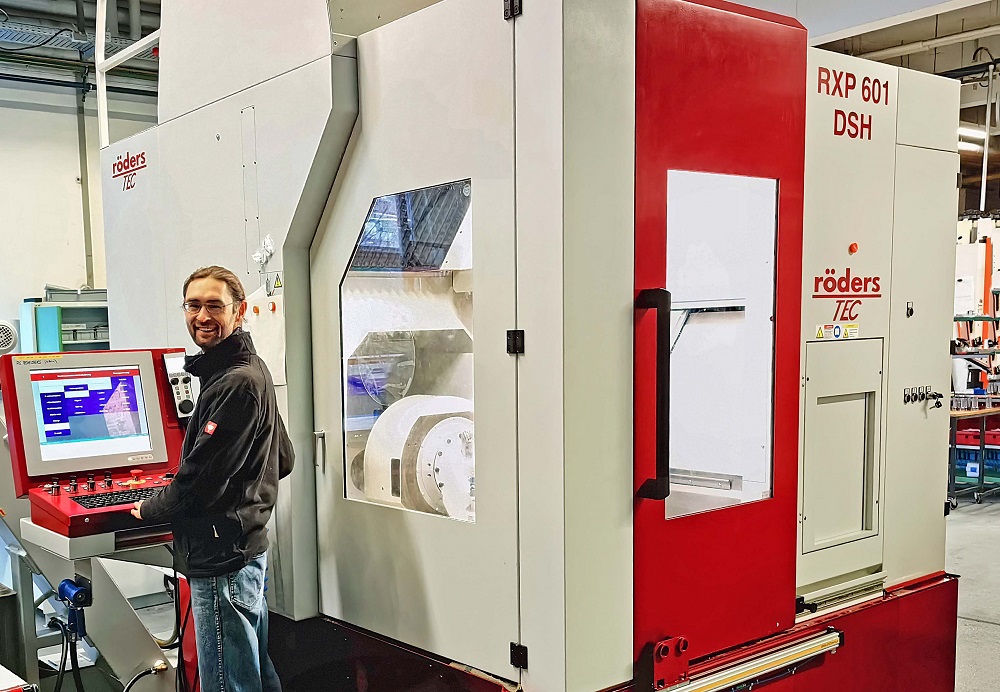The installation of a Roeders five-axis machining centre at Circle GmbH in Weilmünster, Germany, is transforming the engineering service provider’s ability to deliver machined prototypes and small batches of components in short lead times. Roeders machines are available in the UK and Ireland through sole sales and service agent Hurco Europe.
Circle started out in 1998 as a design service provider, initially to the automotive industry and subsequently to the medical, aerospace, optical and other sectors. Customers asked mainly for 3D-printed samples, which it would source from third parties offering stereolithography or selective laser sintering.
In 2007, the company’s first milling machine arrived for producing machined samples of metal parts, mostly from aluminium but also steel, stainless steel and titanium. The company expanded this service consistently and now has three milling centres and four lathes, including a turn-mill centre. In addition, injection moulding machines and equipment for vibratory finishing and shot blasting are in use.
Heiko Legner, managing director of Circle, says: “Our speciality is the production of very high quality, complex, demanding turned and milled parts to tight tolerances in quite small quantities.Examples are components for luxury cars and aircraft interiors in first-class areas, as well as medical apparatus and high-end measuring systems.”
Circle provides engineering expertise prior to part production. The company scrutinises everything, from the CAD file supplied by the customer, through workholding and machining strategies, to identifying cutters that will achieve a certain surface quality. Circle says its engineers help to achieve optimal results, technically as well as economically. Customers certainly appreciate the advantages of this overall package.
Many of the products Circle manufactures have to meet exceptionally high demands in terms of surface quality, not only across flat and freeform areas but also at transitions after a tool change or workpiece re-clamping. So when the procurement of another machining centre was due in 2021, these criteria figured prominently in the list of requirements.
The visual quality of the surfaces after machining was important, but it was also crucial that no witness marks should be visible after anodising. With the machines in operation at the time at the Weilmünster factory, it was often necessary to polish for up to three days after completion of milling to ensure acceptable results for a customer.
In its search for a new machining centre, Circle looked at numerous manufacturers. The number of candidates was initially narrowed down to seven and finally to a shortlist of three, including Roeders. All had to produce a test part from free-issue material to Circle’s precise specifications, which included the NC program and tools. For the production of a second workpiece, the machine manufacturers were invited to attempt a fast cycle time and achieve a high-quality result using their own software and tools.
Nikolaj Sterzer, production manager at Circle says: “After Roeders had produced by far the best result in terms of surface quality in these trials, we evaluated the machine’s endurance at the manufacturer’s premises in Soltau. We put it through a process of extremely hard roughing using a 16 mm milling cutter, and it passed this test well. At the same time, we were able to establish which of the spindle options best suited our requirements.”
The Roeders RXP 601 DSH trunnion-type, five-axis machining centre has been in operation at the Weilmünster facility since April 2022. Sterzer states that installation and training went smoothly and the subsequent telephone hotline support has been exemplary.
He has had no problems with the new control system and found that it offers many interesting options. For example, dripping of coolant from cutters, which can interfere with in-process measurement, is preventable using specific commands.
The efficiency of the RXP 601 DSH derives from its high stiffness and optimal mass inertia layout, reports Roeders. There is two-sided support of the C axis for high stability and precision, while the counter bearing can support up to 7 tonne load. All axes offer high-resolution optical encoders in all axes and wear-free direct drives.
The machining centre offers 540 x 635 x 400 mm in the linear X, Y and Z axes, and a swivelling range of ±115°. Rotation is almost unlimited. The machine supports components weighing up to 200 kg and comes with a 36,000 rpm spindle as standard.
Legner summarises: “We’ve seen cycle time savings of up to 25% using the Roeders machining centre and surface quality is so good after milling that manual finishing is greatly reduced. The benefits are most noticeable at transitions and on freeform surfaces.Another important factor is the quality of the machine manufacturer’s aftersales service. A quick response to problems is just as essential as the equipment’s performance during production. At the end of the day, the best machine is of little use if you have to wait weeks for repairs.”
He adds: “The next phase in the near future will be to automate the RXP 601 DSH with Roeders’ own system so we can switch from the double-shift to 24-hour operation.”
For further information www.hurco.com/gb














